Vol 2 No. 38 TROPIC LIGHTNING NEWS September 25, 1967
Index
| Unit Page | Unit Page | Unit Page | Unit Page |
| 1/5 3 | 1/27 6 | 2/12 6 | 25th Inf 3 |
| 1/5 Photo 3 | 1/27 Photo 8 | 2/14 4 | 3/22 Photo 3 |
| 1/5 6 | 1/27 8 | 2/14 Photos 4 | 4/9 3 |
| 1/5 8 | 1/27 8 | 2/22 Photo 1 | 4/9 6 |
| 1/5 8 | 1/27 8 | 2/22 3 | 4/23 8 |
| 1/27 3 | 2nd Bde 6 | 2/22 3 |
Troops Attack Slopes of Nui Ba Den
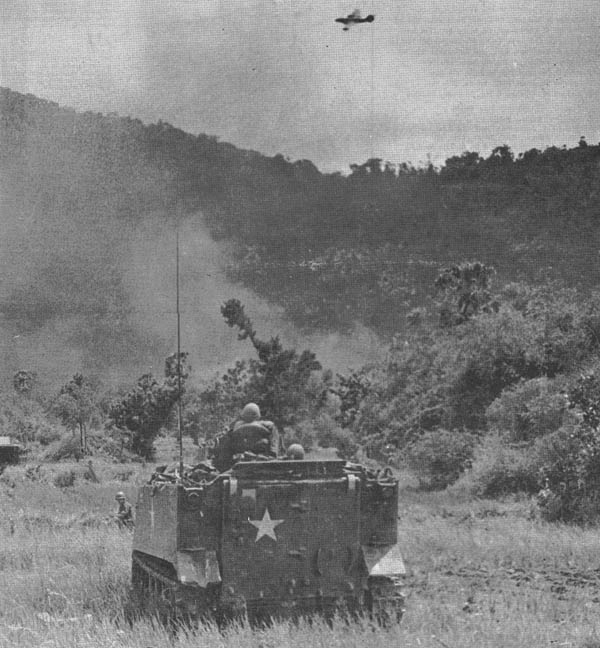 |
| WATCHING AND WAITING - Men of the 2nd Bn, 22d Inf, watch a B-57 streak towards its target as they wait for completion of the strike before assaulting enemy positions on Nui Ba Den north of Tay Ninh. The unit is taking part in Operation "Diamondhead." (Photo by SP4 Jack Maraz) |
Page 2 TROPIC LIGHTNING NEWS September 25, 1967
Decorated
On us the burden falls to lead nations
Out of this frightful wilderness of steel;
On us depends the course of that which is
To come hereafter - whether freedom was
A stolen dream from Heaven, or is the truth
On which to found the future of mankind.
Russell W. Davenport
| SILVER STAR | |
| 1LT Dean H. Guynes, C Trp, 3d Sqdn, 4th Cav | SP4 Leroy Loudis, Co C, 4th Bn (Mech), 23d Inf |
BRONZE STAR (VALOR) |
|
|
1LT Charles A. Linfante, Co C, 4th Bn (Mech), 23d Inf 1LT Douglas C. Colliander, Co A, 2d Bn, 27th Inf 1LT Phillip W. Childress, Co C, 4th BN (Mech), 23d Inf SGT John R. Stephens, Co C, 4th Bn (Mech), 23d Inf |
SP5 Robert Harrison, C Trp, 3d Sqdn, 4th Cav SP5 John D. Jones, A Trp, 3d Sqdn, 4th Cav SP4 Timothy Sheenan, HHC, 1st Bn, 27th Inf PFC Richard M. Trovato, C Trp, 3d Sgdn, 4th Cav |
BRONZE STAR (MERIT) |
|
|
LTC Dennis V. Gentry, HHC MAJ Richard F. Aschettino, HHC, 3d Bde CPT Allyn J. Palmer, HHC, 2d Bn, 12th Inf CPT Walter L. Arrington, HO & Co A, 25th Med Bn CPT William A. Kinsley, Co A, 125th Sig Bn CPT Ludwig J. Scherer, HHC CPT Jack Tyler, HHB, 25th Inf Div Arty WO1 Harley M. Vincent, Co B, 25th Avn Bn MSG John J. Ice, 25th Admin Co PSG Eugene Barton, Co A, 2d Bn, 12th Inf PSG James E. Harris, Co A, 2d Bn, 12th Inf PSG Boyd V. Brock, HO & Svc Btry, 2d Bn, 77th Arty PSG Jack E. Holler, C Trp, 3d Sqdn, 4th Cav SFC William L. Larson, C Trp, 3d Sqdn, 4th Cav PSG George F. Lamothe. HHC, 2d Bn, 12th Inf SFC Nelson T. Omero, HQ & Svc Btry, 2d Bn, 77th Arty SSG Carl E. Lacy, HQ & Co A. 25th Med Bn SSG William R. Ochsner, HH&S Btry, 3d Bn, 13th Arty SSG Robert T. Shimabukuro, HH&S Btry, 2d Bn, 77th Arty SSG Robert W. Summers, HO & Svc Btry, 2d Bn, 77th Arty SSG Elbert L. Baker, C Btry, 2d Bn, 77th Arty SSG Solomon Ball Jr., C Btry., 2d Bn, 77th Arty |
SSG Billy D. Jones, A Btry, 2d Bn, 77th Arty SGT Preston H. Barrs, HH&S Btry, 1st Bn, 8th Arty SP5 Jerry G. Geiger, HH&S Btry, 7th Bn, 11th Arty SGT Niles V. Leonard, Co B, 4th Bn (Mech), 23d Inf SGT Thomas L. Pearson, Co B, 1st Bn (Mech), 5th Inf SGT Earl C. Haupt III, B Btry, 2d Bn, 77th Arty SGT Richard E. Letelier, A Btry, 2d Bn, 77th Arty SGT David A. Chiguina, C Btry, 1st Bn, 8th Arty SP5 Gabriel D. Yanez, HO & Co A, 25th Med Bn SGT Alvarado Rodriguez, Co B, 4th Bn, 9th Inf SP4 Lynden E. Belin, HHC, 1st Bn, 27th Inf SP4 Milton Bennerman, HHC, 2d Bn, 14th Inf SP4 Peter M. Capozzoli, Co B, 1st Bn (Mech) 5th Inf SP4 Joseph Ciccimaro, Co C, 1st Bn (Mech), 5th Inf SP4 Edward Belisle, Co B, 1st Bn, 27th Inf SP4 Lloyd C. Boston, Co B, 1st Bn, 27th Inf SP4 Jerald J. Cable Jr., Co B, 1st Bn, 27th Inf SP4 Paul F. Aucoin, HHC, 2d Bn, 27th Inf SP4 Ralph J. Beauvals, 25th Ml Det SP4 James L. Danouvsky, Co B, 1st Bn (Mech), 5th Inf SP4 Daniel E. Holt, Co C, 1st Bn (Mech), 5th Inf |
ARMY COMMENDATION MEDAL (VALOR) |
|
| CPT William E. Nolan, HH&S Btry, 3d Bn, 13th Arty | |
ARMY COMMENDATION MEDAL (MERIT) |
|
|
1LT William L. Michel, HHC, 2d Bn, 12th Inf 1LT Robert L. Newkirk, HHC, 2d Bn, 12th Inf 1LT Richard W. Saley, HHC, 3d Bde 1LT Richard Ringwald, Co A, 125th Sig Bn SP5 Alvin B. Brown, 25th Admin Co SP5 Richard A. Craig, HHC, 25th S&T Bn SP5 John V. De Nicola, 25th Admin Co SP5 Roy D. Williams, HHC, 1st Bn (Mech), 5th Inf SP5 Anthony S. Bifano, A Btry, 2d Bn, 77th Arty |
SGT James Newton, HO & Svc Btry, 2d Bn, 77th Arty SGT Moses L. Show, A Btry, 2d Bn, 77th Arty SP5 James H. Stadt, HO & Svc Btry, 2d Bn, 77th Arty SP4 William P. Cantwell, Co A, 125th Sig Bn SP4 Douglas D. Santos, Co C, 725th Maint Bn SP4 Dennis Higgins, Co C, 4th Bn (Mech), 23d Inf SP4 Roger D. Johnson, HHB, 25th Inf Div Arty SP4 Leon M. Nicholas, HHD, 125th Sig Bn |
Know Your Enemy
NLF's Terror Campaign
Beginning in February 1964, the National Liberation Front (NLF) began a
terror campaign against Americans in Vietnam. It probably did build morale
among the terrorists; the bombing of the American Embassy on March 30, 1965,
most certainly was for morale building purposes.
The killing of American civilians obviously advertised the Viet Cong in the
United States. The terror also served to disorient Americans in Vietnam and
create within them a sense of psychological isolation. Terror, however, was
not used to the extent it might have been in eliminating American opposition.
The American death rate, for example, could have been much higher in the
1960-1965 period than it was. The initial burst of violence stopped almost as
suddenly as it began. Within a ten day period there were about two dozen major
and minor terror attacks on Americans but the campaign suddenly ceased for
reasons that were never clear.
By studying captured Viet Cong documents and questioning Viet Cong prisoners
it is possible to assemble a fairly complete statement of the Viet Cong
doctrinal approach to terror.
Viet Cong Cadres consider the proper use of terror as terror applied
judiciously, selectively, and sparingly. They have found terror, turned on and
off, paradoxically produces both pro-and anti-guerrilla feelings among
villagers. On the other hand, of course, it engenders fear and hatred, with the
first usually predominating over the second. But when relaxed after an
area-wide terror campaign, an exaggerated sense of relief spreads through the
villagers and they tend to regard the guerrillas as being not nearly as inhumane
as they are capable of being.
Terror, the Viet Cong hold, is virtually useless against a dedicated
opponent. In general, Viet Cong theoreticians consider terror to be the weapon
and as control increases it should be used less.
They hold that from terror a guerrilla band gets rapid but quickly
diminishing returns. And to judge from their terror acts, they believe that
terror works better on friends than on enemies.
They believe that terror is most effective when the general population is
sympathetic to the cause and least effective when it is against it.
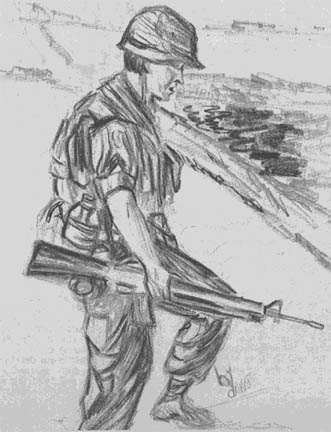 |
To us Americans much has been given; of us much is required. With all our faults and mistakes, it is our strength in support of the freedom our forefathers loved which has saved mankind from subjection to totalitarian power. Norman Thomas |
Your Rights As A Prisoner
Saigon (MACV) - The MACV Command Information Division recently produced and
distributed two pamphlets on the rights of prisoners of war under the Geneva
Convention. These pamphlets, "Application of the Geneva Convention In Vietnam,"
and "Rights and Privileges of the Prisoner of War," were designed to inform
servicemen in Vietnam of the standards of treatment to which prisoners are
entitled.
The following quiz is designed to test your knowledge and understanding of
the Geneva Convention from both the POW and captor's point of view.
Q.: Describe, briefly, the 1949 Geneva Conventions.
A.: International agreements which protect prisoners of war, sick and wounded
military personnel, and civilians against inhumane treatment.
Q.: The fact that there has been no formal declaration of war in Vietnam
nullifies application of the Geneva Conventions. True or False?
A.: False. Article 2 states that the Convention is fully applicable in any
"armed conflict" even when there is no formal declaration of war.
Q.: Can you take a prisoner's metal helmet from him and keep it as a
souvenir?
A.: No. The Geneva Prisoner of War convention (henceforth GPW) expressly
forbids taking anything from a prisoner but "arms, horses, military equipment
and military documents."
Q.: You may threaten a prisoner with physical harm, providing you do not
carry out the threat, if you believe this will make him cooperate?
A.: No. The GPW specifically bans either physical or mental degradation or
abuse.
Q.: An NCO in the U.S. Army may not remove or order the removal of money and
valuables from a prisoner even if he issues a receipt. True or False?
A.: True. Only an officer has this authority.
Q.: Captured chaplains and medics are not considered prisoners of war. True
or False?
A.: True. They are considered retained personnel by the detaining power and
utilized in their normal duty capacity as ministers and medical personnel caring
for the PWs.
Q.: How do PWs bring complaints to the representative of the detaining
authorities?
A.: They have an appointed Prisoners' Representative who is permitted access
to all PWs at any time to check on conditions and grievances. He in turn, may
appoint assistant representatives.
| The TROPIC LIGHTNING NEWS is an authorized publication of
the 25th Infantry Division. It is published weekly for all division
units in the Republic of Vietnam by the Information Office, 25th
Infantry Division, APO San Francisco 96225. Army News Features, Army Photo
Features, Armed Forces Press Service and Armed Forces News Bureau material are
used. Views and opinions expressed are not necessarily those of the Department
of the Army. Printed in Tokyo, Japan, by Pacific Stars and Stripes. Maj.Gen. F. K. Mearns . . . . . . . . . Commanding General Maj. Bernard S. Rhees . . . . . . . . . . Information Officer 1LT Larry Rottmann . . . . . . . . . . . . Officer-in-Charge SSG Dave Wilkinson . . . . . . . . . . . Editor-in-Chief PFC Dave Cushman . . . . . . . . . . . . Editorial Assistant |
Page 3 TROPIC LIGHTNING NEWS September 25, 1967
Destroyer Answers Call To Base Camp
DAU TIENG - If there's anybody that wants to talk direct to a destroyer off
the coast of Vietnam, near the DMZ, just have them get in touch with the
mechanized infantry of the 3d Bde, 25th Div.
Bravo Co, 2d Bn (Mech), 22d Inf, was patrolling their area north of Tay Ninh
City in War Zone C when their company commander, CPT James Bristol of Rochester,
N.Y., decided to call back to base camp on his AN-PRC 25 radio. When an unknown
station broke into the channel, Bristol challenged it.
After receiving cautious comments, such as "We're in the blue, we're an Uncle
Sierra Sierra," and "we're a big boat," it was finally determined that the
radio, with a normal range of 25-30 kms had picked up a destroyer more than 500
kms away near the DMZ.
The destroyer was supporting a Marine outfit ashore and was having trouble
communicating with their forward observer. They asked Bristol if he could relay
a message to the FO to direct the naval guns.
Security precautions prevented getting the name of the destroyer, but if
you're ever monitoring a radio and hear "Palladium calling Allegheny," just
break in and ask how the ocean is that day - if the atmospheric conditions are
just right.
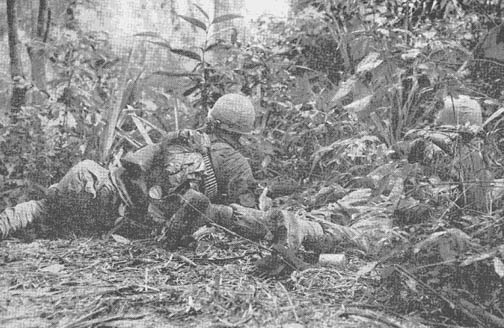 |
DANGER ZONE - Infantrymen from the 3d Bn, 22d Inf, take cover after receiving sniper fire during a search and destroy operation seven kms south of Dau Tieng. (Photo by SP4 Jack Maraz) |
Mech Mortar Platoon Has Speed, Flexibility
DAU TIENG - "Fire for effect!" Thump! Thump! The mortar men of the 2d Bn,
22d Inf, send another load of death screaming toward the enemy.
The 10-ton armored personnel carriers (APC's) of a mechanized unit are armed
with a .50 cal. machine gun and carry an 11 man squad complete with ammunition
and supplies. But some of these vehicles are modified to carry the 4.2 inch
mortar, and are attached to battalion headquarters. The mechanized mortar
platoon, which accompanies the men in the field, is directly under the command
of the battalion commander and provides a flexibility and speed of operation not
otherwise obtained with artillery and air strikes.
A mortar APC has from four to five people on it, such as the 1st squad of the
"Triple Deuce" mortar platoon. SGT Henry R. Scott of Bandette, Minn., is the
squad leader. "It only takes three men to operate the gun," says Scott. "SP4
Francis Covert and PFC Gene M. Gregston are my gunner and assistant gunner."
Requests for action are relayed to the Fire Direction Control unit where the
radio message is plotted and changed to deflection and elevation settings for
the gun. After clearing with the 3d Bde, 25th Inf Div Arty, and air liaison,
the crew cranks the setting in and prepares to fire.
Besides supporting the maneuver elements in the battalion and other units on
call, another important mission is the nighttime harassment and interdiction
(H&I) fires plotted to deny nighttime enemy movement along jungle trails and
streams. All too often this H&I fire changes into a deadly duel with mortars
when the cry "incoming" is heard. The battalion in the past has been mortared
as much as five times in three days. Since the mortar tubes are always prepared
to go, and the sound of enemy mortar firing is easily plotted, the mortar crews
set up and begin firing minutes after the first enemy rounds explode.
"We usually don't see the results of our counter-mortar fire," says SGT
Earnest Hopper of Paucah, Tex., "but occasionally our efforts are rewarded. One
time on Operation Diamondhead we were stationed near the Cambodian border
protecting a CIDG (Civilian Irregular Defense Group) camp while they rebuilt
their camp defense. In one of the daily mortar attacks we got a good bearing on
one of the Viet Cong positions," he added.
"Counter mortar fire stopped the fire from that direction early in the
attack, and next day a CIDG patrol found numerous blood trails and equipment
left behind in the area hit by the counter mortar fire," Hopper said.
|
Ilikai East
October is "Travel Time" at the 25th Div's Ilikai East Service Club. |
3 Viet Cong, 3 Rounds Left
CPT Larry Garlock had seen a lot of things in his four months as a 25th Inf
Div company commander, but nothing like the situation he found himself in
recently 35 kms northwest of Saigon.
The Cleveland, Tenn., officer, a member of the 2d Bde's 1st Bn, 27th Inf
"Wolfhounds," came face to face with three armed Viet Cong. He had only three
rounds left in his M-16 rifle.
Garlock and his command group had followed behind as Alpha Co swept through a
heavily overgrown field.
"They must have thought everyone was past," he said. "All of a sudden there
were three VC with rifles standing up in front of me."
"The four of us just stood there for a few seconds surprised. Then we all
made a move at the same time," Garlock said.
It was a short fight. Garlock dove to one side. The three rounds he fired
killed one enemy soldier and wounded another who was detained. The third man
fled. Garlock was unscratched.
Series of Firsts For 9th Inf GI
An operation in the Iron Triangle north of Saigon marked a series of firsts
for PFC Daniel D. Rodrigues of Somerset, Mass.
The young rifleman, a member of Co B, 4th Bn, 9th Inf, encountered his first
hot landing zone in his first month in the field.
After the company had dug in for the night, Rodrigues was put on perimeter
guard. Later that night he sighted three objects moving along the canal to his
front. He fired one round at the center figure just as an illumination round
lit up the area.
"Two of the targets had vanished and in place of the third was what looked
like a mound of dirt," said Rodrigues. "I didn't fire again because we had
orders to fire only at confirmed targets - and that didn't include anthills."
As the flare went out there was a gasp and then a splash as the "anthill"
fell over into the canal and floated away face down.
A search the next morning revealed a blood-spattered tree trunk with one
bullet lodged in it. It was another first for the 25th Div trooper with his
first shot - his first Viet Cong killed.
Kool Bath
People have been known to bathe in milk, perfumed oils and even beer, but the
25th Inf Div boasts of a soldier who bathes in Kool Aid.
The sticky situation began in the forward base camp of the 1st Bn, 5th Inf,
where SP4 Richard Pawelko of Saddle River, N.J., mixed up a five-gallon G.I. can
of assorted Kool Aid flavors for consumption the next day.
The next morning Pawelko decided to take a shower, and grabbed a five-gallon
water can and poured it into the shower can.
"I was just about finished," said Pawelko smiling, "when some of the water
got into my mouth. It was the sweetest water I had ever tasted."
Realizing his mistake, Pawelko refilled the shower with fresh water and
rinsed himself off.
"I got rid of all the packages of Kool Aid that I've been carrying around for
weeks," says Pawelko, "but I believe it would have tasted better out of a cup."
Camp Cu Chi 'Batch Plant' Pours It Out
Due to the increasing demand for concrete in the 25th Inf Div cantonment
area, and the difficulty in hauling sand, rock and cement over muddy roads, a
new plan was formulated.
All the sand, rock and cement has been hauled to one location and stockpiled
and several cement mixers put on a line to produce the cement. This has allowed
efficiency and production to increase.
This operation is called the "Batch Plant" and is located near Lightning
Bowl.
With full operating capacity of the plant's four concrete mixers, as many as
six, 20 by 48 foot concrete slabs can be produced in one day's operation.
| CLOSE ON THE SIDES - PFC Harold Cantoni (left) of Pennsgrove, N.J., and SP4 Milton Cook of Baltimore, keep soldiers of the 1st Bn, 5th Inf, looking neat with their mobile barber shop. (Photo by SP4 Roger Smith) |
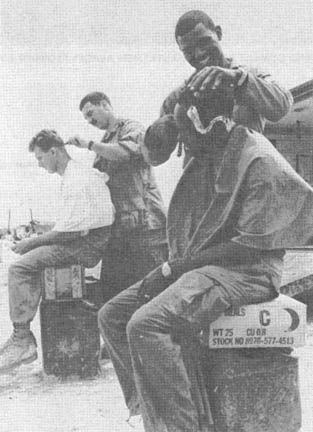 |
Page 4-5 TROPIC LIGHTNING NEWS September 25, 1967
14th Inf Routes Cong from Lowlands
The canals and swamps in the lowlands 25 kms north of Saigon in Binh Duong
Province were the target for a recent search and destroy operation by the 2d Bn,
14th Inf "Golden Dragons."
The infantrymen were dropped by helicopter and started their sweep with the
mission of searching out the Viet Cong, their fortifications and weapons caches.
Rubber rafts and small assaults were used when the Saigon River rose to high
tide flooding the entire area.
All high ground was probed foot by foot for weapons and ammunition storage
points. One such cache was found buried in a canal bank.
|
Photos by Bill Wermine |
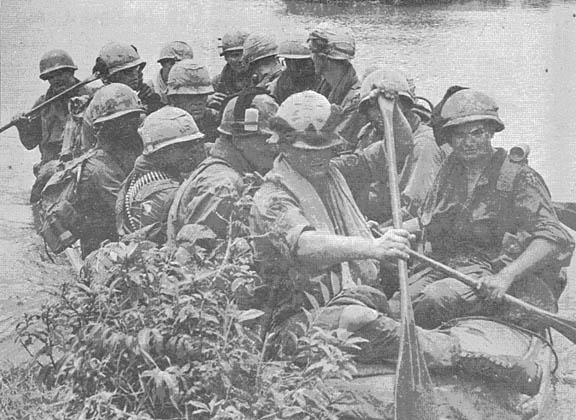 |
| A CROWDED RUBBER RAFT FERRIES COMBAT READY INFANTRYMEN ACROSS FLOODED LOWLANDS 25KMS NORTH OF SAIGON IN BINH DUONG PROVINCE IN SEARCH |
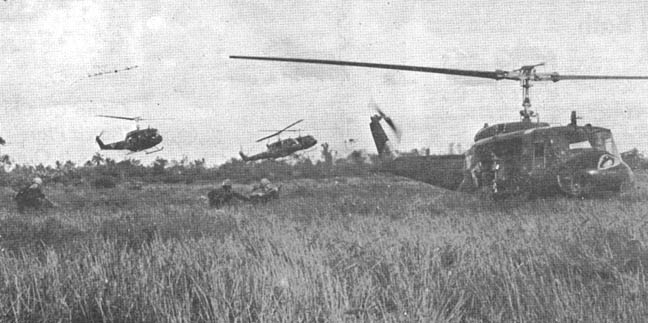 |
| TROOPERS RUSH FORWARD TO WAITING HELICOPTERS TO BE MOVED TO A NEW LOCATION AND CONTINUE THE SEARCH. |
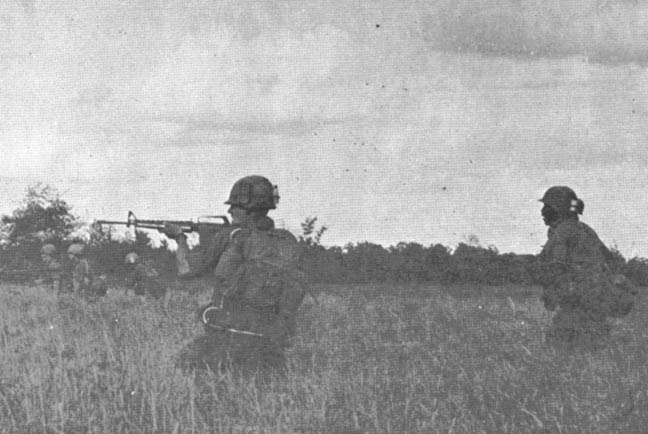 |
| GOLDEN DRAGON TROOPERS OF THE 2D BN, 14TH INF, FIRE INTO THE WOODS AS THEY ADVANCE TO MEET THE ENEMY. |
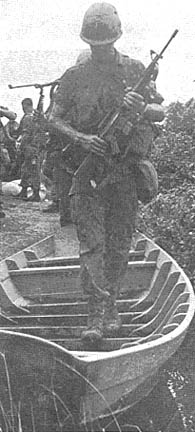 |
ABANDONED BOAT SERVES AS HASTY BRIDGE. |
| INFANTRYMEN EXAMINE RPG-7 ROUNDS DISCOVERED DURING THE SEARCH. |
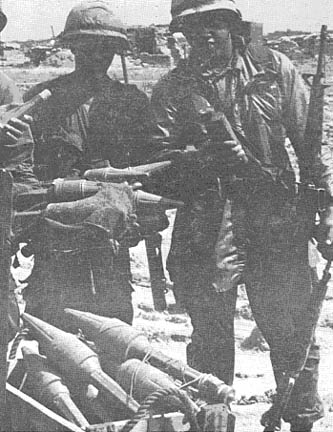 |
Page 6 TROPIC LIGHTNING NEWS September 25, 1967
His First Ambush "Like It Should Be"
"This was my first ambush," said 2LT Jerry Yasher, "and I wasn't
disappointed." Fifteen other new replacements out for the first time agreed.
Just after dusk the Greensburg, Pa., platoon leader led his ambush patrol out
through the 1st Bn (Mech). 5th Inf, barbed wire.
They quietly set up the ambush along the Oriental River northwest of Saigon,
long considered by 25th Inf Div officials to be a main Viet Cong night supply
line.
"Everything was quiet for about thirty minutes when I thought I heard a lawn
mower off in the distance," said radio operator SP4 Edison Atkins of Huntington,
W.Va. The sound was the outboard motor of a twenty-four VC sampan cutting its
way downstream.
"The moon was full," said Yasher, "and we could see them as plain as day.
There were four of them with rifles."
"I waited until the last possible second to give the signal," he said. "When
they were right in front of us we opened up with everything."
The river fell silent again after thirty seconds of fire. "Anything left
alive out there was either an angel or bulletproof," said Yasher.
After resetting the ambush, the rest of the night passed silently.
As the sun rose, the men wound their way in through the barbed wire with a
real combat story to tell about their first ambush.
Some Work Never Done
They say that an infantryman's work is never done - "Wolfhounds" of the 25th
Inf Div's 2d Bde believe it.
After four months of continuous combat in the swamps and rice paddies of Hau
Nghia Province, the 1st Bn, 27th Inf, recently returned to their Cu Chi base
camp.
Anything but a break, the one week stay was spent firing, scrambling through
the mud and patrolling in the unit's annual refresher training.
"The exercise was aimed at introducing new men to the challenges of Vietnam
combat and refreshing the hard won skills of the oldtimers," said operations
sergeant, MSG Jerry Mann of Leesville, La.
Much of the training was conducted in the vast Filhol rubber plantation east
of the Div's base camp.
The training site was the scene of several fierce battles fought when the
brigade first entered the area in January 1966.
The last night's exercise came to a crashing end with triggering of the
battalion's total defensive fires.
Battalion Commander LTC David Hughes of Colorado Springs, Colo., called the
"break" from combat operations a complete success.
"For the new men it was the closest thing to actual combat," he said, "and
for the oldtimers it taught them new techniques and procedures."
Diamondhead Keeping Cong Off Balance
DAU TIENG - The 2d Bn, 12th Inf, 3d Bde, 25th Inf Div, moving into the third
month of Operation "Diamondhead" have constantly kept the Viet Cong of Tay Ninh
Province on the move. Under the command of LTC James F. Greer, the troops of
the 2d Bn, 12th Inf, have been conducting search and destroy missions throughout
this area.
The 2/12 has become a swifter moving battalion with the support of the 188th
Avn Co, which is based at Dau Tieng. The battalion over the past two weeks has
carried out six airmobile assaults into the Tay Ninh area, thus making it
impossible for "Charlie" to know where the "Warriors" will strike next.
The effectiveness of the swift moving Warriors has caused the VC in this area
to be under constant pressure and has decreased the Viet Cong activities
throughout Tay Ninh Province.
Since the beginning of Operation Diamondhead the battalion has destroyed 184
bunkers and seven military structures. It has also captured a total of four
thousand pounds of polished rice, two hundred pounds of rock salt, twenty
bicycles, sixty-eight grenades, twenty 82mm mortar rounds and a medical cache of
three hundred bottles of penicillin and large quantities of antibiotics.
Commo Letter Helps Solve Talk Problems
Trouble with communications comes when people talk too much on it and not
enough about it. That's the opinion of new 2d Bde communications officer, MAJ
Raymond K. Howell.
His answer to the problem came recently with the publication of the first
Warrior Commo Newsletter.
The weekly news sheet is aimed at solving everyday problems with commo
equipment and encouraging proper maintenance.
"Response to the first letter was very favorable," says Howell. "This is the
best way we know to let everyone in the brigade in on tips that can mean more
dependable radio and telephone operation."
Included in the letter are sections on technical topics, personnel changes
and even a joke column.
Job Changes Each Situation
A man never knows what he'll be doing next in the Army, as PFC David L.
Ruggles of Flint, Mich., recently found out.
Ruggles was part of a two-man radio and forward observer team attached to the
4th Bn, 9th Inf, during a sweep through the Iron Triangle, 45 kms north of
Saigon.
On landing in the area they were hit with sniper fire, and the two
artillerymen had to perform as riflemen. That evening Ruggles' forward observer
was wounded by a sniper and had to be evacuated. This left the young radio
operator to do both his own job and his partner's.
"He did real well, especially for a first-timer," said Co B's SGT George E.
Velez of Brooklyn, N.Y.
 |
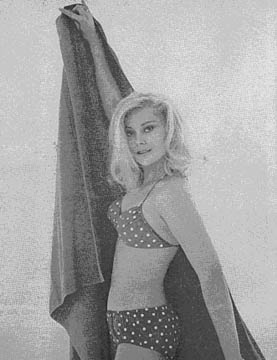 |
| SEEING DOUBLE - On the beach or elsewhere, Lisa Jak seems to be all GI could ask for. (Photo Courtesy 20th Century-Fox) |
Page 7 TROPIC LIGHTNING NEWS September 25, 1967
Page 7 contained "The Leading 1967 College Football Schedules...", which has not been reproduced for this online issue
Page 8 TROPIC LIGHTNING NEWS September 25, 1967
Hot Food Forgotten In Bottle
It had been a long weary day for the 1st Bn, 5th Inf, soldiers. When they
were told that they wouldn't be going back to camp for the evening meal, looks
of disappointment crossed their faces, but even food was forgotten in the action
that followed.
Had a Hunch
"We had been on a sweep during the day and we were tired," said 1LT Victor
Larkins, recon platoon leader from Titusville, Fla. "I had a hunch that the
Viet Cong was using the Oriental River during the little time that our
activities were suspended in the evening. I received permission to check it
out."
A seven man ambush team was placed in position along the river bank. Two of
the APCs were hidden in the thick underbrush for rear security and the other
three were returned to the forward base camp.
As the sun dropped below the horizon, the men heard a motorized sampan moving
down the river towards their ambush.
"We could hear the VC in the boat, laughing and having a good time," said PSG
Horst Adam of Honolulu. "At first, we thought there was only one, but as they
moved past us, we spotted two more."
Adam triggered the ambush by firing a rocket at the lead sampan, which
immediately sank. The second boat was hit by a rocket fired by Larkins.
All Over
"After that, all hell broke loose!" said SP4 David Seely, a machine gunner
from New Orleans. "I opened up on the third boat with my M-60 machine gun and
it was all over. We had M-79 grenade launchers and M-16 rifles supporting us."
A secondary explosion started a fire which sank the last ship. Eight VC were
killed in the onslaught.
Returning to the forward base camp, the worn out soldiers discovered they
hadn't been forgotten. Hot chow had been saved for them which completed the
successful evening.
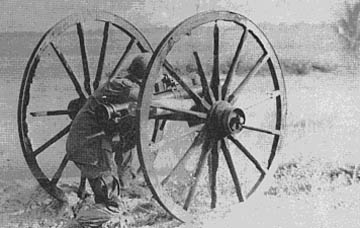 |
A THING OF THE PAST - An inquisitive gunner from the 1st Bn, 27th Inf "Wolfhounds," has mounted his 90mm recoilless rifle on a Viet Cong oxcart wheel assembly just to see how it was done during the Revolutionary War. The Wolfhounds were on a 25th Div operation in Hau Nghia Province. (Photo by SP4 Bruce Dapprich) |
Candy Bar Is A Good Trade
An ordinary chocolate candy bar proved itself an effective weapon against the
Viet Cong during a 25th Div operation.
Co A of the 1st Bn, 5th Inf, had been providing security for a road building
project by the 65th Cbt Engr Bn. As the armored personnel carriers moved into
their positions near the small town of Loc Thanh, in Hau Nghia Province, a group
of children converged on the vehicles.
"I was sitting on my APC when a small boy came up to me and wanted gum," said
PFC John McCabe, a rifleman from Spring Lake, N.J. "I couldn't resist the look
on his face, so I gave him a candy bar instead."
With the candy in his pocket, the boy and four of his friends motioned to
McCabe to follow them. McCabe and several other men were led to a hedgerow
about 50 meters from their position.
"When we got there," continued McCabe, "my little friends pointed out three
butterfly bombs that were hooked up with trip wires and one 105mm artillery
shell hidden in a hole."
A demolition charge was attached to the boobytraps and they were blown in
place.
Late that afternoon, the little boys left for home each with chocolate on
their hands, 100 piaster reward in their pockets, and looks of satisfaction on
their faces.
Remington Rangers
A typist, an operations center radio operator, and a group of clerks recently
joined together to form one of the most unusual security patrols in the history
of the 25th Inf Div.
Named after their usual "weapons," the Remington Rangers were formed to
provide security for a fire support base in Hau Nghia Province northwest of
Saigon.
Their unit, the 1st Bn., 27th Inf "Wolfhounds," was involved in an overnight
combat operation north of the base.
Led by 1LT Ronald Marsh of New Kensington, Pa., a staff officer with platoon
leader experience, the men loaded up their gear, weapons and ammunition and took
up posts just before dark.
"Everyone in the Army has infantry training," said Marsh, "but for most of
them this was their first taste of field duty."
An all night monsoon rain and reports of enemy activity evidently convinced
the Rangers that this was the real thing.
"It was the coldest night I have ever spent in Vietnam," said SP4 Robert
Early, a clerk from Middletown, Ind. "I really gained a lot of respect for the
infantryman who faces this every night."
SP4 Dana Howlett of South Bend, Ind., added, "I enjoyed it. After hearing
everyone else's war stories for so long, I finally have one to tell."
According to Marsh, it was a one time operation but many of the men say
they're ready to go at it again.
"Even though we didn't make enemy contact it was quite an experience," said
Early.
One Letter Brings 50, But Writer Is Killed
Last March, PFC Jack Kuri decided that what his 25th Inf Div platoon needed
was more mail from home.
His answer was a plan that created a 12,000 miles bridge of letters from his
hometown of Washington, D.C., to Cu Chi, Vietnam.
The 1st Bn, 27th Inf "Wolfhounds," soldier wrote a letter to a friend at the
Library of Congress. "A letter in the field after a day's fighting means
everything," he wrote, "maybe you can pass our address around the library."
The response was tremendous - 50 people wrote. They formed a Wolfhound Club,
and the mail continued to flow.
"The whole front office typing pool, our section upstairs, the elevator
operator, and lots more write regularly now," said Maryanna Fontanesi, an active
club member in the Aerospace Technical Section.
"The letters are a tremendous morale booster," says PSG Louis Colon of Puerto
Rico. "It makes all the difference in the world to a man to know the folks back
home are thinking of him."
The combat hardened soldiers won't forget the great idea Kuri had when he
wrote that first letter. He was killed on Operation "Manhattan," one month
after he wrote it.
VC In Rush Pulls Boo Boo
"I saw a hat come out of a small tunnel with a Viet Cong under it," explained
SSG Hai Lenam, an ARVN interpreter attached to Co B, 1st Bn, 27th Inf
"Wolfhounds." "When he spotted us he started to run and I grabbed him."
The company, led by CPT Larry Garlock from Cleveland, Tenn., had his men on
line with the command group as rear security recently on a search and destroy
operation 40 kms northwest of Saigon.
The men were slowly passing the opening when the Viet Cong made his mistake.
During interrogation the detainee said he thought all the Americans had
passed.
'Tomahawks' Go Airborne
The Tomahawk troopers of Co C, 4th Bn (Mech), 23d Inf, left their armored
personnel carriers at home and went airborne during an operation west of Cu Chi
in Hau Nhgia Province.
While eagle flights are frequent missions for infantry battalions, this was a
"first" for the 1st Bde unit as they usually prefer tracks as their means of
transportation. Despite being unaccustomed to helicopter operations, the
campaign went off smoothly and successfully.
Enemy contact was negative when they came into the landing zone, but evidence
that VC had been in the area was found in the form of numerous booby traps.
Thanks to:
Jim Frost, 2nd Bn., 22nd Inf.,
for sharing this issue,
Kirk Ramsey, 2nd Bn., 14th Inf. for creating this page.
This page last modified
02-16-2008
©2008 25th Infantry Division Association. All rights reserved.